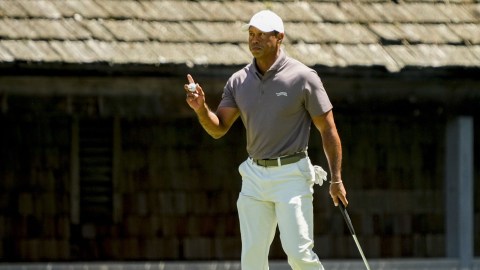 Golf’s governing bodies approved a new rule Tuesday that outlaws the putting stroke used by four of the last six major champions, going against two major golf organizations that argued long putters are not hurting the game.
Golf’s governing bodies approved a new rule Tuesday that outlaws the putting stroke used by four of the last six major champions, going against two major golf organizations that argued long putters are not hurting the game.
The Royal & Ancient Golf Club and U.S. Golf Association said Rule 14-1b would take effect in 2016.
“We recognize this has been a divisive issue, but after thorough consideration, we remain convinced that this is the right decision for golf,” R&A chief executive Peter Dawson said.
The new rule does not ban the long putters, only the way they commonly are used. Golfers no longer will be able to anchor the club against their bodies to create the effect of a hinge. Masters champion Adam Scott used a long putter he pressed against his chest. British Open champion Ernie Els and U.S. Open champion Webb Simpson used a belly putter, as did Keegan Bradley in the 2011 PGA Championship.
“We strongly believe that this rule is for the betterment of the game,” USGA president Glen Nager said. “Rule 14-1b protects one of the important challenges in the game — the free swing of the entire club.”
The announcement followed six months of contentious debate, and it might not be over.
The next step is for the PGA Tour to follow along with the new rule or decide to establish its own condition of competition that would allow players to anchor the long putters. PGA Tour commissioner Tim Finchem said in February that the USGA and R&A “would be making a mistake” to adopt the rule, although he also has stressed the importance of golf playing under one set of rules.
Some forms of anchoring have been around at least 40 years, and old photographs suggest it has been used even longer. It wasn’t until after Bradley became the first major champion to use a belly putter than the USGA and R&A said it would take a new look at the putting style.
“It can never be too late to do the right thing,” Nager said.
Those in favor of anchored putting argued that none of the top 20 players in the PGA Tour’s most reliable putting statistic used a long putter, and if it was such an advantage, why wasn’t everyone using it?
“Intentionally securing one end of the club against the body, and creating a point of physical attachment around which the club is swung, is a substantial departure from that traditional free swing,” Nager said. “Anchoring creates potential advantages, such as making the stroke simpler and more repeatable, restricting the movement and rotation of the hands, arms and clubface, creating a fixed pivot point and creating extra support and stability that may diminish the effects of nerves and pressure.”
The governing bodies announced the proposed new rule on Nov. 28, even though they had no statistical data to show an advantage. What concerned them more was a spike in usage on the PGA Tour, more junior golfers using the long putters and comments from instructors that it was a better way to putt. There was concern that the conventional putter would become obsolete over time.
The purpose of the new rule was simply to define what a putting stroke should be.
“The playing rules are not based on statistical studies,” Nager said. “They are based on judgments that define the game and its intended challenge. One of those challenges is to control the entire club, and anchoring alters that challenge.”
The topic was so sensitive that the USGA and R&A allowed for a 90-day comment period, an unprecedented move for the groups that set the rules of golf.



